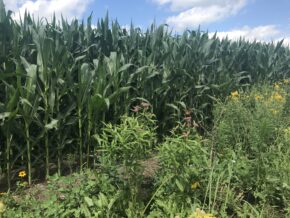For both eastern and western monarch populations, vast areas now used for agriculture were once sustaining breeding grounds. The Midwestern U.S. (also called the Corn Belt) used to be an important source of milkweed habitat for monarchs. In the West, California's Central Valley served the same purpose, with plentiful monarch milkweed and nectar resources for millions of western monarchs. In both regions, milkweed used to grow abundantly even after agricultural fields were first established, but the growing farming industry and development of Roundup-ready crops and other pesticides have devastated milkweed abundance in much of the Corn Belt and the Central Valley. Prior to the incorporation of Roundup-ready corn and soybeans and other pesticide-treated crops that utilize post-emergence applications of glyphosate, plowing was the main means for ridding fields of “weeds.” This allowed some persistence of milkweed habitat within agricultural fields and surrounding areas, whereas the shift to increased glyphosate use totally eradicates milkweed from the field, and spray drift can have harmful effects on areas surrounding agriculture fields.

Additionally, corn that is genetically modified to contain a toxin from the bacterium Bacillus thuringiensis may have a harmful effect on monarchs if exposed to it. This “Bt-corn” is toxic to the European corn borer but also to other Lepidoptera. Pollen and anthers from Bt-corn can be harmful to monarch larvae if ingested, but it is thought that since milkweed is essentially gone from agricultural areas, exposure to this pollen is low and thus, the effect on monarchs is negligible.
In the past few decades, there has been an increase in the amount of agricultural land conversion in the Corn Belt due to increasing demand for corn and advancing agricultural technology, allowing farmers to efficiently manage more acres. Research by scientists from the Universities of Iowa and Minnesota in 2012 showed a direct correlation between declining monarch numbers and increasing adoption of herbicide-tolerant soybeans and corn. With the loss of agricultural habitat, it is key that we ensure that milkweed and monarch nectar plants are available in other areas.
The loss of milkweed in agricultural fields across the U.S. is a major cause of the decline in monarchs, though there are other factors contributing to the decline in milkweed availability. Herbicide application and increased mowing in roadside ditches and agricultural margins is eradicating milkweed habitat even more from rural areas. If managed appropriately, roadsides could provide millions of acres of habitat suitable for monarchs and other pollinators. These areas are often mowed or sprayed regularly throughout the growing season to control weedy species, but if transformed into a native plant community, they could require significantly less maintenance once established while providing important habitat. If mowing is used to manage weedy species or invasive species, it is best to do it during times when monarchs will be least affected by the disturbance. In addition, leaving sections of the habitat untouched will allow pollinators and other wildlife to find refuge in those areas while the disturbed portion of the site recovers.
Urban sprawl and continuing industrial development are also major factors influencing the decline in quality monarch habitat. Other anthropogenic factors, such as ozone pollution or increased carbon dioxide levels, can affect the health and distribution of milkweed plants.
For more information about creating healthy habitat for monarchs with a focus on agricultural areas, please explore our Habitat Program and the Creating Healthy Pollinator Habitat educational handout.
